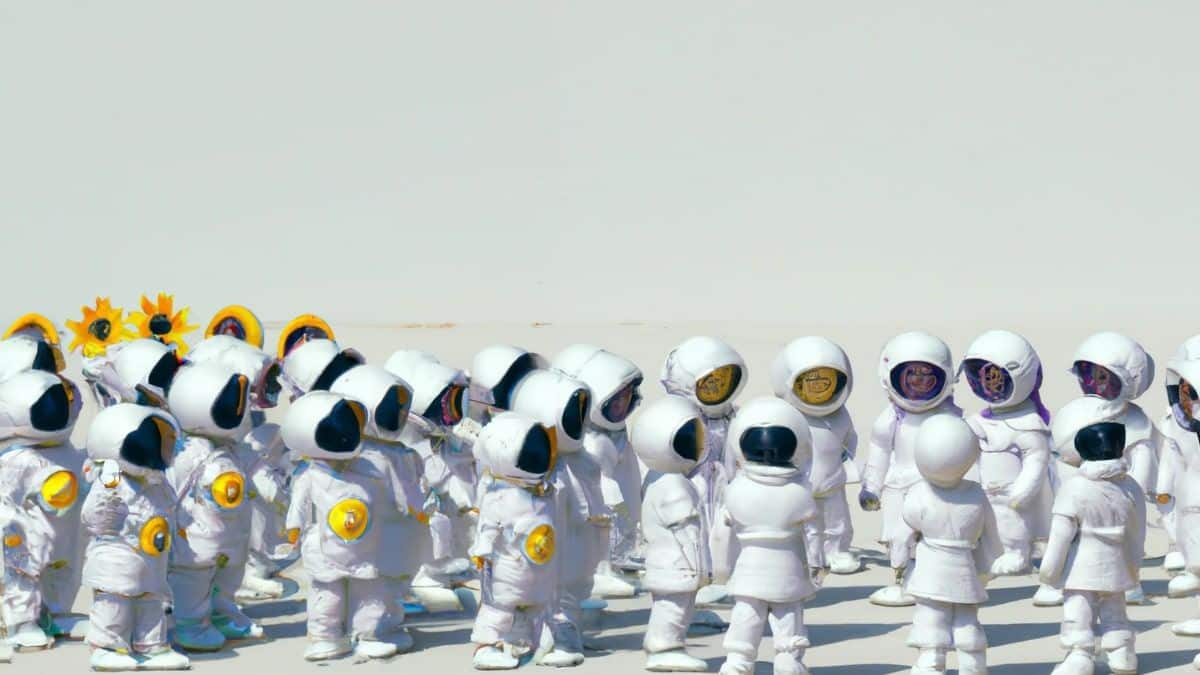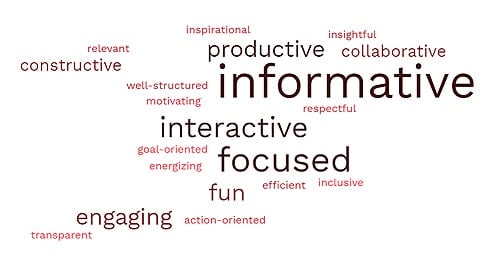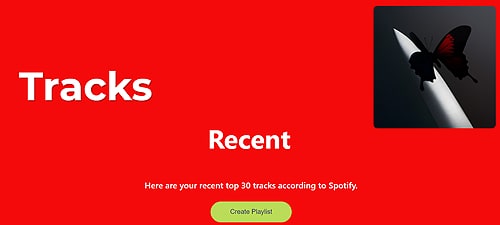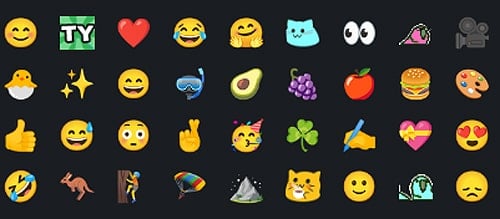You found our list of large group icebreakers.
Large group icebreakers are games or activities to get teams of 20 people or more talking to each other. Common examples include “Never Have I Ever” and “Most Likely To.” The purpose of these icebreakers is to help build relationships and spur discussion among people who may have trouble getting the conversation started by themselves. These activities are common at meetings and other corporate settings and are also known as “ice breakers for large groups.”
These activities are a subcategory of icebreaker games, team building games, and indoor team building activities and are similar to get to know you games, 5 minute team building activities, and large group energizers.

On this list you will find:
- icebreaker games for large groups
- large group ice breaker games
- get to know you games for large groups
- big group ice breaker games
- ice breakers for big groups
- corporate icebreakers for large groups
- meeting ice breakers for large groups
- team icebreaker games
- icebreaker activities for large groups
Here we go!
List of large group icebreakers
When you have a large team, it may be difficult for people to chat because not everyone may be familiar with each other. If this situation describes your team, then check out this list of icebreakers for large groups.
1. Hello, My Name Is…

For teams that do not know each other yet, Hello, My Name Is… is a large group icebreaker game where employees form a circle and introduce themselves with their name and a quirky fact about themselves.
Then, the next person introduces everyone who has gone before them, along with their fun facts, before introducing themselves. If a participant forgets a team member’s introduction, then the introductions start over again. The team wins when they are able to go around the circle without making any mistakes.
The goal of this icebreaker is for your team members to learn each others’ names and to associate names and faces with easy-to-remember facts. When your colleagues run into each other in the future, they are more likely to recognize each other. “Hi, Michael that only owns one shirt.” Not to mention, they will have shared topics to talk about, which facilitates team bonding.
You can also ask questions to get to know someone.
2. Icebreaker Bingo
One of the best games to play with large groups is icebreaker Bingo. Most people are familiar with the rules and format, which makes the game quick to start. Plus, you can keep track of winners and award fun prizes.
Here is an icebreaker Bingo card generator for your games.
3. Most Likely To ______
Most Likely To is a simple to put together large group icebreaker activity where participants assign who is most likely to do certain activities. Prior to the game starting, compile a list of “most likely to’s”.
Examples of great “most likely to’s” include:
- Most likely to go river tracing
- Most likely to win a cook-off
- Most likely to make it to the final round of American Idol
- Most likely to have been a K-pop star in a past life
- Most likely to invent the next big tech marvel
- Most likely to be a secret superhero
- Most likely to go bungee jumping
- Most likely to play office pranks
When you wish to play, gather everyone into a large circle, and read out the first item on your “most likely to” list. Then, players vote on who is mostly likely to complete that activity and briefly explain why they feel it is true. Once voting is done, pass the list on to the next participant and repeat the process.
Most Likely To is a stellar large group icebreaker because the whole team participates equally, and the activity can be scaled up or down depending on group size. Additionally, Most Likely To reveals your team members’ impressions of each other, which results in funny revelations.
Here is a list of most likely to questions to ask.
4. Desert Island Intelligences
If you ever took a psychology class, then it is likely that you have heard of Gardner’s Theory of Multiple Intelligences. This large group icebreaker game takes inspiration from Gardner’s theory and asks your team to decide who they would eliminate from a desert island.
Gardner’s eight intelligences are:
- Visual-spatial
- Linguistic-verbal
- Interpersonal
- Intrapersonal
- Logical-mathematical
- Musical
- Body-kinesthetic
- Naturalistic
The premise of Desert Island Intelligences is that eight individuals, each embodying one of the intelligences, get stranded on a desert island. These folks know that the island’s resources cannot support them all, so they must slowly vote their compatriots off the island. Your team needs to figure out what order they should boot off the eight intelligences, using logic to debate each other to back up their decisions.
Because of its intriguing premise, Desert Island Intelligences easily gets your team talking, even if they were unfamiliar with each other at the start. The team building game also exposes how your team members think and what kinds of intelligences they prioritize in survival situations.
For similar activities, check out this list of problem solving activities.
5. Never Have I Ever
Never Have I Ever is one of the most exciting ways to learn weird facts about your coworkers. In this game, each player holds up a certain number of fingers. Each turn, players name one action that they have never done. If a participant has done the activity, then they put a finger down. The first person to run out of fingers wins. For large groups, have players hold up ten fingers instead of five so the game lasts longer.
Some amusing Never Have I Ever prompts are:
- Never Have I Ever been skydiving.
- Never Have I Ever visited South America.
- Never Have I Ever gotten suspended.
- Never Have I Ever broken a bone.
Never Have I Ever is a large group icebreaker because the prompts will naturally prompt discussion as players ask each other to reveal the stories behind each statement. Because of this aspect, your team grows closer as they learn more about each other.
Check out this list of the best Never Have I Ever prompts for work.
6. The Neverending Story
The Neverending Story is a great large group icebreaker for exercising your team’s creativity. To start, begin telling the first sentence of a story. Then, pass the story on to the next person. Each following individual elaborates on what the previous speaker created.
The Neverending Story makes a fantastic icebreaker because having so many people collaborating on the same story results in a complex plot. The story will be more rich and complicated than you may have anticipated.
Here are more fun improv games to try.
7. Achievements Under 18

Achievements Under 18 is an intriguing icebreaker to learn about your employees’ pasts. To play, gather your team and have everyone share one achievement they are proud of that they accomplished before they turned 18 years old.
Since the achievements must have occurred before age 18, this icebreaker provokes interesting discussions. The game also shows what your employees valued at that age, revealing parts of their personality that you may not have known about previously.
8. Hot Takes
Have you ever had a hot take that surprised everybody? Hot Takes is a fun game for large groups that asks employees to reveal a controversial opinion they have about a certain topic.
Some great Hot Take topics include:
- Best cuisines of the world
- Best pizza toppings
- Best movies from the ’80s
- Best rap artists
- Best celebrity for president
Because this game prompts participants to reveal their opinions, your team will learn new information about each other. Also, due to their controversial nature, the hot takes are sure to stir up discussion among your team as well.
9. Two Truths and One Lie
Two Truths and One Lie is a game where each person puts forth two true statements and one lie and asks everyone else to guess which statement is the lie. Because of the nature of the game, team members learn about each other through the truths and lies they tell. You can play Two Truths and One Lie with as many players as you want, which makes this game suitable for both large and small groups.
10. Business Card Tag

Business Card Tag is one of the most effective ways to hold a large group icebreaker. Before the activity, remind your team to bring their business cards to the gathering. It does not matter if your coworkers decide to bring personal or company business cards.
For this exercise, your team’s goal is to collect as many business cards as possible. When colleagues give their business cards to one another, they must write down three fun facts about themselves on the back of the card. The player who amasses the most business cards by the end of 40 minutes wins. At the game’s conclusion, the victor reads through the business cards they collected.
New colleagues who are part of larger organizations will benefit from playing Business Card Tag because they will end up with a rolodex of their coworkers’ business cards and learn three fast facts about them by the end of the game. By setting up this activity, you introduce your team members to each other in an inventive and unforgettable way.
11. Community Mural
Designed for artistically-inclined teams, Community Mural is a very relaxed icebreaker. First, divide your team into groups, and hand out large poster boards and art supplies. For those who want an office makeover, you may also assign large swaths of the walls for this activity instead.
After you have given out supplies, set your team loose, and have them create a mural. You can choose to have your team paint or draw designs or have them write words that inspire them or describe their ideal workplace.
Either way, encourage your team to relax and chat with each other while they work. Community Mural is a terrific icebreaker for large groups because it creates a calming atmosphere for colleagues to get to know each other while they demonstrate a new skill and make the office a more aesthetically pleasing place.
Here is a list with more community building activities.
12. This or That
This or That is a fun questions game for large groups. To play the game, line your team up in conversation pairs and prompt them with simple this or that questions. In each round, the players take turns saying their choice and stating why.
Here are a few questions to get started with:
- Sleep on a sofa or a water bed?
- Visit Jupiter of Saturn?
- Dogs or cats?
- Apple pie or cheesecake?
Here is an entire list of this or that questions.
13. Group Juggle

Icebreaker activities are a great time to get to know colleagues’ names, especially in large groups.
Here is how to play the game:
- Gather the group into a circle.
- Give one player a ball.
- Player one will say a colleague’s name and throw the ball at them.
- Player two must say who they received the ball from, then say the name of who they will throw the ball to.
- The game continues until players call each participant’s name at least once.
Learning colleagues’ names in large groups can be difficult, especially between departments. Group Juggle adds an element of fun to introduce large teams.
14. Trading Cards
Sports trading cards are a snapshot of each player and help fans learn more about them and their stats. You can incorporate this idea into your next team building event by creating personalized workplace trading cards!
Here is how to host this activity:
- Provide participants with crafting materials like blank index cards, markers, pens, and stickers.
- Give participants time to create their own trading cards. For example, employees could include a self-portrait, their job title, and their years of experience. Cards could also include information like favorite foods, favorite movies, and fun facts.
- Once the cards are ready, have participants swap with colleagues.
- Optionally, the host could collect each card and make copies to share with the whole group.
Creating trading cards is a creative icebreaker to help colleagues learn more about each other.
15. Live Word Cloud

A live word cloud is a versatile way to get a read on your audience. This activity is great for large groups because there is no limit to how many participants can contribute.
You can use several platforms to host a live word cloud session, including Mentimeter, Poll Everywhere, and Slido. These programs allow audience members to share their opinions in real time. Hosts simply ask a question the group can answer in one word, and attendees respond. Then, the sites arrange the responses in a colorful display, with the most common answer being the largest.
Some examples of word cloud prompts include:
- What team member do you think deserves recognition?
- In one word, describe last week’s team event.
- In one word, how would you describe an ideal meeting?
- How are you feeling today?
- What did you learn this week?
- Whether you want to see how the group is feeling or brainstorm for a new product, a word cloud is a great choice.
Learn more about Mentimeter, Poll Everywhere, and Slido.
16. Sound Check

Music is one of the best ways to connect, and musictaste.space can help large groups compare their top song picks.
Here is how to host this activity:
- Log in with your Spotify account.
- The site will give you a code to share with friends.
- Once all participants sign in, they can see personal insights, including top tracks, artists, and genres.
- Musictaste will compare colleagues’ stats and give them a compatibility score.
- Participants will also see which songs and artists they have in common.
- If coworkers score above a 50% compatibility level, then the website will generate a unique playlist based on their preferences.
Getting to know a large group can be intimidating, but shared music tastes is one of the fastest ways to break the ice.
Learn more about musictaste.space.
17. Emoji-thon

With the popularity of remote work and social media, emojis are one of the fastest communication methods. With just a single image, you can convey a whole host of emotions. Sharing your most commonly used emojis is a quick way to explain your communication style.
To host this activity:
- Choose a messaging platform, like Slack or Discord.
- Create a channel for fun activities, and add all participants.
- If your group is in person, then display the chat on a large screen.
- Have participants take a screenshot of their frequently used emojis and share it with the chat.
You can even react to these emoji pictures with your own emojis! This lighthearted and quick activity shares insights into a teammate with one snapshot.
18. Mundane Minute
At some point in your career, a manager has likely asked you to share a fun fact with your team. Sometimes, respondents feel on the spot and cannot think of an interesting enough fun fact. Mundane Minute flips this concept on its head by asking participants to share a not-interesting fact about themselves.
Here are some examples of not-interesting facts folks might share:
- I always fold my socks before putting them away.
- I eat tuna salad for lunch three times a week.
- I sleep on the left side of the bed.
- Mayonnaise is my favorite condiment.
- I live on the third floor.
With these small details, colleagues can get to know each other on a more day-to-day level. Plus, no one has to feel pressured to frantically come up with an interesting enough fact.
19. Where in the World

Large teams often feature diverse employees from across the globe, and Where in the World is a great way to learn about their cultures!
To play this game:
- Players must think of three clues representing where they are from. For example, a player from Australia could name fairy bread, macadamia nuts, and opals. The clues should not give away the location too easily, like the Sydney Opera House.
- Other players guess where the first player is from.
- The first player who guesses correctly earns a point.
- Play continues until every participant has a turn to share clues.
If participants are all from the same country, then players could also share clues about their favorite overseas locations. Where in the World is a great way to go on a global adventure from the comfort of home!
20. Sequencing Squad
Sequencing Squad is a great way to learn several new facts about colleagues at once.
To play the game:
- Create categories you could sort participants into. For example, players could line up by descending height or birth months.
- Split the group into teams. Since you have multiple prompts, you can rearrange teams between questions so all participants get a chance to mingle.
- Read out a prompt.
- Teams will sort themselves into a line based on the prompt.
- As a bonus, you can write down information for later, like players’ birthdays.
You can play this game repeatedly, making it an excellent icebreaker.
21. Baby Yoga
Yoga is a great way to get your team moving and shake off the morning blues. Having a baby host your yoga session adds a fun layer of chaos to this activity!
To host this exercise:
- Ask a worker to volunteer to bring in their baby. This activity works best if the baby can stand and move independently but is not very coordinated yet.
- Find a large open area with a stage where participants can see the baby.
- Play some music the baby likes to encourage them to move and groove.
- Participants must mirror the movements of the baby as best as they can.
While traditional yoga is all about intentional movements and breathing, baby yoga is a silly way to encourage activity and laughter.
22. Beach Ball Bonanza

Beach Ball Bonanza is an inexpensive way to encourage a large team to learn more about each other.
Here is how to play the game:
- Blow up a large inflatable beach ball.
- Gather participants in a big open space.
- Bounce the beach ball in the air, and instruct players not to drop it.
- If any player lets the beach ball touch the ground, then they must share a fun fact about themselves.
Chasing a beach ball around will get teams’ blood pumping, and sharing fun facts will help them get to know each other better. Both functions of this game make it a great icebreaker.
Final Thoughts
Doing icebreakers is a great way to build connections, comfort, and community in large groups. The games and activities on this list can help contribute to a successful team retreat, conference, or other event type. Plus, there is not a limit on how many icebreakers you can do with your group, so the more, the merrier!
Next, check out our list of icebreaker books, this one with icebreaker questions for meetings, and these fun connection games.
We also have a list of Christmas icebreakers for work, one with office Olympics ideas, and one with fun activities for work groups. Plus, the best office mixer activities for large groups.
